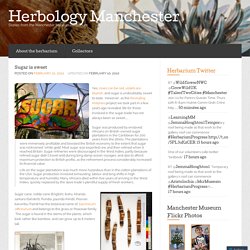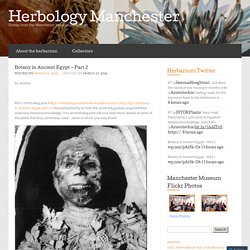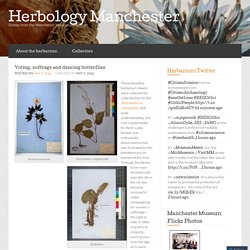

An introduction and how to remount specimens « Herbology Manchester. An introduction and how to remount specimens Posted on Hello!

My name is Jamie and I am the curatorial apprentice within the herbarium.I have been here since February and will continue to be here until the following February (2015). I have been in the herbarium for 5 months now, and we thought it was time for me to introduce myself to the blog. My first 5 months in the herbarium have involved quite a variety of different tasks. Along with the mentioned above, I have also been doing some remounting of specimens.
The photo above shows the area the remounting will be taking place. As you can see in the first image, the specimen is placed in a flimsy folder and is not in a very good condition. As you can see in the above images this specimen clearly needs to be remounted. The above images are of the gummed tape we use – this tape is acid free and can last a very long period of time. To get the gummed tape to stay secure, we have to wet both ends. Like this: Like Loading... A New Year in the Agricultural Calendar « Herbology Manchester. A New Year in the Agricultural Calendar Posted on Updated on Chinese New Year, also known as New Year in the Agricultural Calendar, is just round the corner.

As billions of people get ready to welcome in the New Year we have had a look into the role botany plays in the festivities and at some of our more important Chinese donations. Oats are important in the celebration of the New Year. On the eighth day of the lunar month before the new year a traditional porridge is made and served to each member of the family called làbāzhōu (臘八粥), pardon my Mandarin… Bamboo sticks, along with fireworks and firecrackers, are burnt to make as much noise as possible on the first day if the New Year.
At midnight on the eighth day of the New Year the Hoklo people (Han Chinese people whose traditional ancestral homes are in southern Fujian) will offer thanks giving prayers to the Emperor of Heaven, commonly offering sugarcane. Blog post By Alyssa, Herbarium Placement Student. Like this: Like Loading... Sugar is sweet… « Herbology Manchester. Sugar is sweet… Posted on Updated on Yes, roses can be red, violets are blueish, and sugar is undoubtably sweet to taste.

However, as the Revealing Histories project we took part in a few years ago revealed, life for those involved in the sugar trade has not always been so sweet… Sugar was produced by enslaved Africans on British-owned sugar plantations in the Caribbean for 200 years from the 1600s. The plantations were immensely profitable and boosted the British economy to the extent that sugar was nicknamed ‘white gold’. Sugar cane, noble cane (English), Ikshu, khanda, sarkara (Sanskrit), Pundia, paunda (Hindi), Poovan karumbu (Tamil) has the botanical name of Saccharum officinarum and belongs to the grass or Poaceae family. Below are two jars of sugar which came from Tate and Lyle Ltd, Liverpool. Like this: Like Loading... Botany in Ancient Egypt – Part 2 « Herbology Manchester. Botany in Ancient Egypt – Part 2 Posted on Updated on by Jemma Part 1 of this blog post ( focused primarily on how the ancient Egyptians acquired their extensive botanical knowledge.

This second blog post will now look more closely at some of the plants that they commonly used – some of which you may know! One of the most well-known plants associated with ancient Egypt is Cyperus papyrus. Safflower (Carthamus tinctorius) is a brightly coloured flowering plant that has heads of yellow, orange or red. Ancient Egyptian tombs often contained baskets of juniper berries (Juniperus communis). Allium sativum, commonly called garlic, was used for both culinary and medicinal purposes by the Egyptians. Believed to have been made by the god Thoth, Papaver somniferum (opium poppy) was used medicinally as an early form of painkiller and in cooking to add flavour to baked goods like bread. Like this: Like Loading... Voting, suffrage and dancing butterflies « Herbology Manchester. Voting, suffrage and dancing butterflies Posted on Updated on These beautiful herbarium sheets were collected by Lydia Becker for the 1864 Botanical Competition and quite understandably she won a gold medal for them.

Lydia Becker was enthusiastic about science but was frustrated by the limitations put on women at the time. Through this desire to be more involved with scientific life in the UK she became involved in wider campaigning for women’s sufferage – the right to vote. In 1860, only 60% of property-owning men over the age of 21 were allowed to vote. I hope Lydia Becker would have been pleased by the efforts of the artist Romuald Hazoumè to encourage everyone to make use of their hard-earned right to vote* and become a Butterfly activist………. We particularly want to encourage first time voters to participate, but anyone of voting age can be a butterfly activist. . * Key dates in universal suffrage 1918 – All men over 21 in their county of residence gained the vote. Like this: